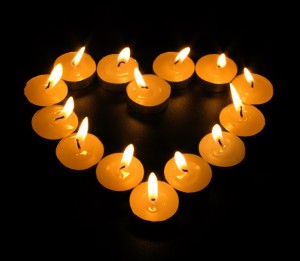I broke into tears when I told my partner that new information indicated that many of the children killed today at a school in Newtown, Connecticut were kindergartners. Five years old.
Friends on Facebook posted about their shock and grief and prayers sent to the families affected by the horror.
President Obama had to pause for twelve full seconds during his short address to the nation, right after he said, “The majority of those who died today were children — beautiful little kids between the ages of 5 and 10 years old.” Looking down, he brushed tears from his eyes.
My tears had just dried only to start again when I went to research something for this post and saw that Google had placed a tiny, somber candle underneath their search bar. Hovering my cursor over the candle, I read the words that faded into view: “Our hearts are with the families and community of Newtown, Connecticut.”
So say we all.
Grief, meaning, and the questions before us
It seems to me that there are three pressing questions that we now face:
How do we manage our grief?
How do we get perspective on this?
How do we make sure this never happens again?
Grief
Much has been said today about the parents who rushed to the school to desperately look for their children.
In near-panic, they burst into the secured firehouse and scoured the faces in front of them, hoping to find their child.
Most of them, thankfully, did.
Twenty sets of parents did not.
Our hearts break for them.
But it is not only these parents who face the ravages of grief and shock.
Death has touched so many more. The brothers and sisters, aunts and uncles, grandparents and cousins. The playmates and friends.
The kindly crossing guard who knew each of her charges. The cashier at the supermarket who knew that father and his son. The former students who lost a beloved principal and, possibly, favorite teachers.
The grief spreads from person to person like water finding its way across a cracked and dry desert. First in rivulets but then, as those rivulets merge together, the water becomes a stream and then a river. The grief of the parents becomes the grief of Newtown becomes the grief of a nation.
Just last week I wrote a post on the absolute and utter pain of grief and how, sometimes, you just have to go through it even if it means being knocked to your hands and knees.
And I hate it – I hate it – that so many people are on their hands and knees now.
But, as Shauna Shapiro said, “We accept our experience not because we want it, but because it is already here.”
This experience, this tragedy is here. Let grief run its healing course.
If you are surprised by the intensity of your grief right now, realize that your reaction is completely normal. How can you not grieve the senseless loss of so many young children? How can you not think, “There, but for fortune, go I?”
Death is a part of our common humanity as is the grief that accompanies it. You are sharing in our collective sorrow.
Do what you need to do to process your feelings. Perhaps it helps to talk about Newtown with a friend. We’re having a discussion on Facebook – join us there. Maybe it helps to write in a journal about how this tragedy reminds you of your own losses.
Perhaps you could create a small ritual to honor your own grief and those of your brothers and sisters in Connecticut. Light a candle. Write “Newtown, Connecticut” on a slip of paper and put it in your Bible or hold it against your heart or tuck it under your pillow.
Trauma
If you are feeling vicariously traumatized by the events in Newtown, make sure you take care of yourself. Create a space where you feel safe both physically and emotionally. Talk to trusted loved ones about your feelings.
And breathe, remember to breathe.
As you breathe in, allow the place in your body that is feeling anxious to soften. As you breathe out, let go of any judgments you are having about yourself.
This is an excellent time to practice self-compassion. You may want to take advantage of Kristin Neff’s wonderful guided meditations on her website, especially “Soften, soothe, allow.”
Anger
Acknowledge your feelings – all of them. And that includes anger.
A friend of mine emailed me and strongly encouraged me to write this post, to step up and do what I can to help.
I sent her back an expletive-laced email that exploded with anger. Not at her, but at the gunman and the situation.
I felt better afterwards.
Anger is an extremely common aspect of grief and a very normal reaction under circumstances like these.
Acknowledge it, honor it, but don’t let it overwhelm you.
We’ll talk later about productive ways to use your anger.
Perspective and meaning
Resiliency research has shown that being able to provide meaning to adversity is an essential part of being able to bounce back.
This usually involves finding a positive aspect, some silver lining to a crisis. Maybe a new opportunity arises in one area of your life when a bad thing happens in another. Or maybe the crisis begins to make sense later when you get a bigger picture of the time frame in which it occurred.
It’s going to be hard to find a silver lining here.
How do we make any sense at all of a senseless act?
Maybe we don’t right now.
Remember that meaning-making and perspective take awhile. It’s part of our human tendency to chew on things for a bit before we figure them out.
As Amy wrote on my Facebook page tonight, “I want to be in touch with my sadness and be aware of my feelings around the tragedy. I’m not ready to move on. I want to feel connected to this event as I try to make sense of what the Universe intended.”
It’s okay to not be able to figure this out yet. It’s hard because we so want to understand, we want for it to make sense. Our brains are struggling with this contradictory data that they’ve encountered.
For now, try to soften around this urge for meaning. Like Amy, allow yourself to feel connected to your feelings and the event itself, but let the meaning-making happen naturally.
I think, though, that there is one thing we need to solidify rather than soften.
The time is now
Columbine.
Virginia Tech.
Aurora.
Newtown.
No more.
The time is now.
We must not – cannot – turn away from this again.
An article in Mother Jones, accurately and sarcastically called “A Guide to Mass Shootings in America,” lists 61 – now 62 – mass murders by gunfire since 1982.
Our resiliency individually and as a nation relies on working together to solve problems.
We can blame things on Congress, or the President, or oil companies, but it boils down to what we do. What I do. What you do.
We must not let opinions about guns and gun control divide us.
As President Obama said, “We’ve endured too many of these tragedies in the past few years. And we’re going to have to come together and take meaningful action to prevent more tragedies like this, regardless of the politics.”
This is the time we must unite despite our differences. We must find an answer to the terrorism of gun violence.
This is the time for compassion, empathy, and action.
If you don’t agree with your neighbor on the solution to gun violence, remember that he deserves as much compassion as you do because of your very humanity. Put yourself in his shoes and understand that he is taking responsibility for his beliefs as you are for yours.
Practice mindfulness by staying with the current issue and adopting a non-judgmental stance with people who don’t agree with you. You can disagree and still be loving and kind.
And be practical. Allow your anger to energize you to action, but don’t post vitriol on Facebook. Post ideas and solutions.
All of us, no matter our opinions on guns in America, must act now before there is more bloodshed, more grief, more trauma.
Write your Congressperson and tell her you expect action to be taken on a federal level to address this issue. Call your Senator and tell him the same thing.
Have a conversation with your friends and brainstorm how you can affect the process.
We have to figure this out. It has to stop here.
Do it for yourself.
Do it for our country.
Do it for the children.
It’s important that we talk about this. Let me know what you’re thinking and feeling in the comments below.
Other resources:
For a great start in processing this, see Sarah O’Leary’s terrific post “Is There Love Even Here?”
For tips on how to talk with kids about the tragedy.
Please do join us on Facebook to keep talking, processing, and problem-solving.




